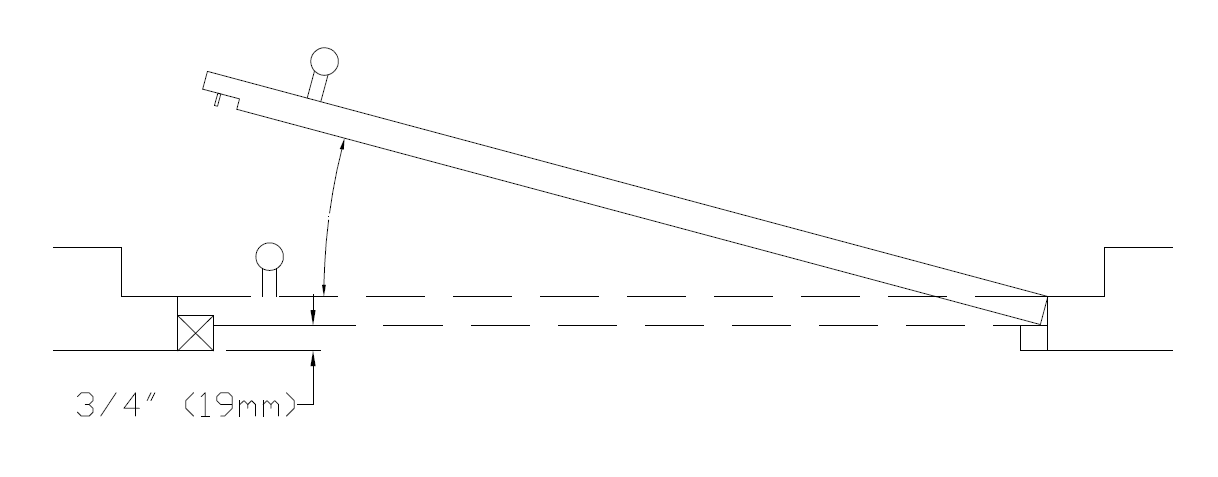The ASME A17.1 Safety Code for Elevators and Escalators can be intricate, encompassing a wide range of safety standards and technical requirements. However, understanding the key rules can make a significant impact on ensuring passenger and worker safety. One of the fundamental aspects of this code is the 3/4" & 4" rule, which governs the door clearances in hoistways, ensuring both operational efficiency and safety. In this guide, we'll break down the 3/4" & 4" rule into practical terms that can be easily applied during installation and maintenance processes.
The Basics of the 3/4" & 4" Rule
The "3/4" & 4" rule" refers to the maximum clearances allowed for hoistway doors:
- 3/4-inch clearance: For swing doors, the gap between the hoistway side of the landing door and the edge of the landing sill should not exceed 3/4" (19mm). For sliding doors, the clearance can be up to 2.25" (57mm).
- 4-inch clearance: The gap between the hoistway side of the landing door (or gate) and the car door (or gate) must not exceed 4" (102mm).
These clearances are vital for preventing individuals or objects from becoming trapped or injured between the elevator car and the landing door, ensuring that the space remains safe during all phases of elevator operation. Proper adherence to these limits helps minimize the risk of accidents, such as pinching or crushing, particularly when the elevator is in motion or during door closing.

Eclipse Residential Elevator Design
For those involved with the Eclipse Residential Elevator, it's important to note that the design includes a maximum running clearance of 1.25" (32mm), which is significantly less than the standard 4" clearance allowed for other elevators. This reduced clearance not only meets but exceeds standard safety expectations, minimizing the risk of accidents by reducing the available space where objects or individuals could potentially become trapped. This tighter specification emphasizes the manufacturer's dedication to providing a safer environment for passengers, particularly in residential settings where safety concerns are often heightened.
Common Violations and Recommendations
While the 3/4" & 4" rule seems straightforward, there are common violations, especially in certain structures. Concrete block or masonry shafts, as well as some commercial metal door frames, often fail to meet these clearance requirements due to the inherent challenges in precise construction or alignment. Additionally, environmental factors, such as settling or shifting of the building structure, can also contribute to these violations over time. Using solid doors instead of hollow ones can help, as hollow doors frequently do not meet the pull-out force requirements for door locks, compromising safety. Solid doors provide greater structural integrity and ensure the required pull-out force is met, reducing the likelihood of non-compliance.
Additional Guidance
Here are some additional tips for compliance:
- For doors with a pattern on the hoistway side, measure the 3/4" setback from the deepest part of the door to the landing sill to ensure full compliance. This ensures that even decorative or textured doors meet the necessary clearance standards, which can often be overlooked if only the most protruding parts of the door are considered.
- For accordion gates, flush doors are recommended rather than having a 3/4" setback, reducing the risk of gate intrusion into the hoistway. Accordion gates have a tendency to shift or flex, and using flush doors helps to maintain consistent clearances, reducing the likelihood of gate components entering the hoistway space.
- The 3/4" setback is achievable when using bi-fold or slim car doors, which help maintain necessary clearances without compromising safety. These types of doors are designed to fold or collapse in a way that keeps them clear of the hoistway, providing a more efficient use of space while ensuring safety compliance.
Ensuring Compliance with the 3/4" & 4" Rule for Elevator Safety
The 3/4" & 4" rule is a crucial aspect of the ASME A17.1 Safety Code, serving as a foundational safety standard for elevator systems that directly impacts the safety and efficiency of elevator operation. This rule is more than just a measurement guideline; it is a preventative measure designed to safeguard passengers, maintenance personnel, and property. By ensuring that the clearances between hoistway doors and car doors are within the prescribed limits, the risk of accidental entrapment, pinching, or injury is significantly reduced.
Whether you are an elevator mechanic, inspector, or involved in any part of the elevator installation or maintenance process, understanding and correctly applying this rule ensures the overall safety and reliability of the entire system. It is critical to remember that these clearances, though they may seem like minor details, have a significant influence on the safe operation of the elevator. Poor compliance can lead to severe accidents, mechanical failures, or even long-term system damage, making adherence to these measurements essential for maintaining public trust and safety in vertical transportation.
In practice, maintaining these precise measurements helps minimize risks such as pinching, crushing, or entrapment, which can occur when clearances are insufficient or inconsistent. Additionally, compliance with these rules also contributes to prolonging the lifespan of the elevator system, as improper clearances can lead to increased wear and tear on door components, eventually resulting in costly repairs or replacements. By taking the time to ensure proper clearances, elevator professionals contribute to a safer and more reliable infrastructure for everyone.
As always, safety first!


